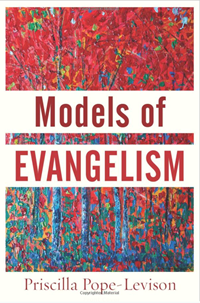8 Models of Evangelism: #1

Here is the summary point: “The gospel spreads most effectively across an existing network of relationships.” So writes Priscilla Pope-Levison in quoting Tom Stebbins. We are looking at one of the Jesus Creed 2020 Books of the Year called Models of Evangelism.
Here is the quote in an embedded paragraph:
The conundrum that avoidance and ambivalence presents is that fewer and fewer Christians in the United States are willing to engagein whatis the most effective model of evangelism. As Tom Stebbins writes, “The gospel spreads most effectively across an existing network of trust relationships.” What then to do? If you are someone who resists the very thought of per-evangelism, I would ask you to suspend your hesitation,pur down your crossed arms, and quiet your criticisms just long enough to read carefully the rest of the chapter, in which you may find some surprising, even admirable,qualities of personal evangelism that you have yet to encounter or consider.
She goes to John 1:39-46 and the “come and see” expression from Andrew. To John 3 and Nicodemus, to John 4 and the Samaritan woman, and to Acts 8 and Philip. Sufficient biblical evidence for proposing “personal” evangelism as a model.
The theological foundations are Christology and Pneumatology, esp the incarnation of making God visible in the Son and in humans, and in the Spirit’s work, “the divine instigator and guide.”
Look, she suggests, for divine appointments with people (she tells a cool story), think of the Spirit at work to inspire what to say, and remember the Spirit is doing the deep work of convictions.
Historically: she appeals to the story of Dwight Moody, John R. Mott, college ministries like InterVarsity and Navigators and Cru, and to Chuck Colson.
Personal evangelism has a “stark simplicity” to it.
It requires no theological degree.
Begin with Lifestyle Evangelism Raise Your Evangelistic Temperature Foster the Relationship Share the Gospel by asking questions, telling your faith story, and using a rubric (4SL, etc.) Follow up
It demands no need to control a conversation.
It necessitates no hyperspirituality.
It certainly requires no sacred space.
A cafeteria will do, as will a shoe store, a home, or a prison cell.
At the same time, there are pracrical foundations that can enhance the practice of personal evangelism.Personal evangelism needs no set place, no set time, no set form, and no set preparation; it demands no church, no cost, no organization.

In her appraisal, Pope-Levison recognizes, admits, empathizes – pick your word – with the deeply personal and vulnerable element of personal evangelism.
What to do, then? She suggests first to remember that the primary agent is the Holy Spirit, and to identify someone to be a mentor in evangelism, and to be patient with yourself, to send up some test balloons (questions), and to practice listening.
There is a tendency at times to think personal evangelism erases the church from the conversation. It does and it can and it always will, one thinks. It deserves more context in evangelism.
Jesus Creed is a part of CT's
Blog Forum. Support the work of CT.
Subscribe and get one year free.
The views of the blogger do not necessarily reflect those of Christianity Today.




















